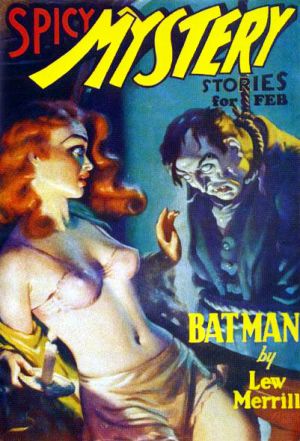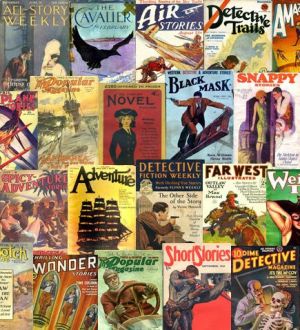The American Pulp Magazine
Measuring initially at a mere 7" x 10", generally containing around 128 pages, Pulp magazines became an American phenomenon around 1896 until the mid-1950s — coining this period, The Age of the Pulps. Inspired by popular, mass selling dime novels and boys’ magazines, the aftermath of World War I birthed Pulp magazines as the new “it” fiction forum for their inexpensiveness and accessibility for national and international marketplaces. Pulps were known for their racy and action-driven storylines, which gave Americans a handful of much-needed heroes and entertainment during the Great Depression.
The term “pulp” is derived from the magazines’ pages being made from wood-pulp, leaving the pages brittle and yellowed over time. A pulp's price typically costing between 5-10 cents, thus inviting Americans of even the poorest working classes to afford entertainment and enrich themselves in the phenomenon. The Pulp industry was entirely dependent on revenue from sales and word of mouth trading with zero marketing. Pulp magazines differ from pulp novels in size and length — however, they are created from the same pulpwood and consist of the same storytelling genre, thus joining forces to create momentum for the Pulp Fiction movement.


Origin
Key Features
- Title
- Cover Page Illustration
- Specific Genre or Genre Mix
- Publisher
- Author
- Issue Month
Most Common Genres
- adventure
- aviation
- fantasy
- ganster
- mystery/detective
- railroad
- romance
- science fiction
- soft pornography — known as "spicy/saucy"
- sports
- gangster
- humor
- horror
- war
- Westerns
Science fiction and crime novels initially were called Weird Tales, Black Mask, and Amazing Stories — as revealed below in The Pulp Magazine Archive's topics section. Likewise, science fiction is often shortened to SF.
The Age of the Pulps
The Age of the Pulps (1896-1955) accounts for the era in which pulp fiction became a household literature genre with cultural capital. Renowned publisher Frank Munsey birthed the first Pulp magazine, Argosy in October of 1896, wherein Munsey transformed the pre-existing children's weekly magazine (1882) into a 192-page adult magazine. Munsey was the visionary behind cheapening the printing process in terms of printing costs, paper, and authors. In only half a decade after that, Argosy skyrocketed from a couple of thousand copies printed each month to half a million. Following Argosy's success in 1903 came The Popular Magazine, a new and improved color version of Munsey's creation and a dime novel—Street & Smith,— turned pulp. The Popular Magazine's success increased the average price of pulp to 15 cents, with the same seasoned authors writing, for now, specialized genres within the pulp fiction genre.
With little to zero advertisement involved, Pulp magazines were sold on an if-you-know-you-know basis, adding value to individual copies of the magazines as rare collector’s items. With bulks only releasing singular copies once at a time. For this very reason, Pulp gathered a large following and phenomenon, ushering in the phrase “pulp fiction” to describe its inexpensive aesthetic, relying heavily on stories rather than photography or illustrations. The subject matter — ranging from exciting taboo and exploitative topics such as crime, sci-fi, fantasy, and violence — added to the attraction of pulps for the American people.
The Pulp Magazine Archive
The Pulp Magazine Archive is a collection of over 13,000 digitized copies of pulps (1919-2020), sponsored by UC Santa Barbara. One can locate various pulps either by year, subject area/topic, publisher, language, or keywords.

Categories
- Views
- Title
- Date Published
- Creator

Media Types
- Collections (6)
- Texts (13,466)
Languages
The majority of archives are written in English, totaling 12,915 copies. However, the archive includes copies in a multitude of languages, listed below from most to least popular:
English (12,915), French (201), Serbian (18), Polish (17), Portuguese (5), Danish (4), Basque (3), Hungarian (3), Slovak (3), German (2), Italian (2), Swedish (2), Estonian (1), Handwritten English (1), Indonesian (1), Spanish (1), Urdu (1), and Welsh (1).
Topics
It is noted that the majority of these topics are repetitive or minimally different; however, nonetheless important to consider when looking at how topics from archives are formed.
From Most to Least Popular
Pulp, Science fiction, Magazine, Fiction, Science fiction, Pulp Magazines, Pulps, Periodicial, Fantasy, Pulp, Young man, Pulp magazine, Adventure, Mystery, Fantasy, Weird tales, Detective, Eyes, Magazine, Crime, Fanzine, Brady, King, Harry, King brady, Bradys, Young king, Sf, Supernatural, Horror, Stories, SF, Western stories, Replied, Years ago, Science, Martians, Martian SFF, Sci-Fi, Motion picture, Horror Fiction, Horror, Ghost stories, Horror Stories, Mars, Westerns, American wit and humor, Supernatural stories, French, Opta, Western fiction, Amazing stories, Crime stories, Movie fan magazine, Ship, H.P. Lovecraft, Magazines, Long time, Full directions, Pulps, Blue book, Short stories, Alice, Fiction, Health knowledge magazines, Television, Interzone, Amazing stories, Robert A. W. “Doc” Lowndes, Captain, Robert E. Howard, Pulp magazine, Galaxy, Man, Periodicals, Clark ashton smith, Comic books, Dime novel, Seabury Quinn, Full instructions, Galaxy science, Advertises, Theater, 1932, Astounding, Secret service, Detective, Mentor, Wall street Wild west, Magazine of horror, Motion Pictures, Movies, Fantastic, Adventure, Gossip, Mentor association, Sci-fi, and Young wild.
The Pulp Magazines Project
The Pulp Magazines Project is an internationally popular digital archive (receiving over 1.5 million views) devoted to showcasing cover-to-cover pulp magazines dating back to the twentieth century, created in July 2011. The project is accessible for the unlimited research of publishing history and, therefore, the fluctuating print culture landscape evolution. The Pulp Magazines Project (PMP) seeks to preserve the rich background of pulp magazines — including renowned authors, artists, and publishers — to counteract the medium's historical neglect. PMP's mission is informatively — through advertising workshops, conventions, and conferences — to create a community and sounding board for artists, academics, fans, and collectors, who share a passion for pulp magazines.

Contents
- Origin of the Pulp Magazine Project
- Magazines in the Archive
- Cover Gallery of Pulp Magazines from 1896 to 1946
- Digital Archive Hub of the Pulp Magazine Project
- Contextual materials/essays
- Biographical materials/essays
- Literature about pulp magazines
- Contacts (Editorial Board, Digital Scans, Contributors, Student Interns, Advisory Board, Submission for Biographical Notes, & Donations)
Sponsors
- The University of Pittsburg
- Dickinson
- The Andrew W. Mellon Foundation
- Moonets
- Blue Mountain Project
- All digital facsimiles are licensed by Creative Commons International 4.0
Decline of the Pulps
The 1920s and 30s accounted for the peak in pulp popularity, culturally and economically. During the mid-1930s, comic books and paperbacks began to filter into magazine stacks, posing direct competition to pulps. Even so, after World War II and the Great Depression, the pulp industry suffered tremendous losses, forcing the industry to fall under large men's illustrated and small digest magazines, which contained the same wood-pulp paper. In the early 1940s, popular pulp magazines, notably Argosy, melded into the stylistic likings of a large flat format men’s illustrated magazine stay afloat. This “large pulp” format featured 8" by 11" — more generally mirroring the magazines we find and see today. The invention of television in the late 1940s additionally contributed to the disintegration of pulp magazines on newsstands, which reached its peak in the mid-1950s, where what could be only be found of the pulps were their bones in new men's illustrated or digest magazines.
References
- “History of the Pulps.” Pulpworld.com. Web. 11 Dec. 2012.
- Robinson, Frank M., and Lawrence Davidson. Pulp Culture: The Art of Fiction Magazines. Portland, Or.: Collectors, 1998. Print.
- Ron Goulart, Cheap Thrills: An Informal History of the Pulp Magazines. New Rochelle, N.Y.: Arlington House, 1972.
- The Pulp Magazine Archive. (n.d.). Retrieved December 10, 2020, from https://archive.org/details/pulpmagazinearchive
- Tony Goodstone, ed., The Pulps: Fifty Years of American Popular Culture. New York: Chelsea House, 1970.
- “Pulp Magazines.” American Decades. 2001. Retrieved December 9, 2020. http://www.encyclopedia.com.
- Pulp Magazines Project. (, 2020). Retrieved December 10, 2020, from https://pulpmags.org/
- What Is Pulp Fiction. (2013). Retrieved December 11, 2020, from https://www.vintagelibrary.com/pulpfiction/introduction/What-Is-Pulp-Fiction.php
Further Reading
- The Pulps: Fifty Years of American Popular Culture (1970)
- Cheap Thrills: An Informal History of the Pulp Magazines (1972)
- Pulp Culture: The Art of Fiction Magazines (1998)